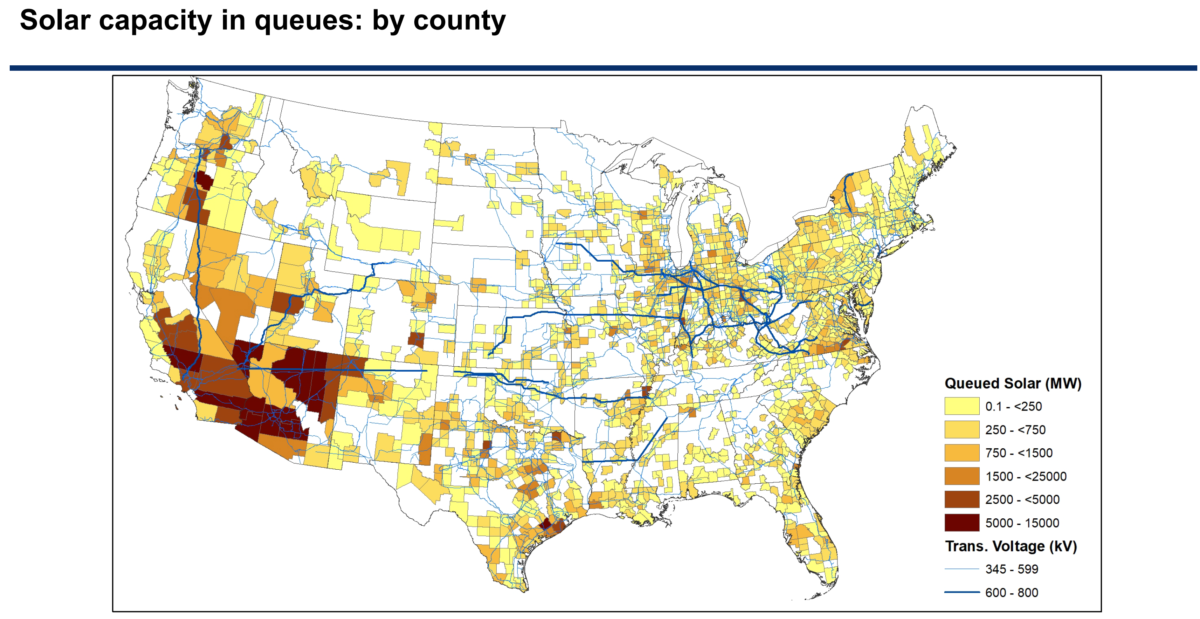From pv magazine USA
As the US power grid electricity generation project queues continue to grow, its composition is evolving. Solar and batteries are beginning to dominate the nation’s energy future.
The US Department of Energy’s Lawrence Berkeley National Laboratory’s Electricity Markets and Policy group (EMP) has released its annual power grid queue update. The nation’s queue holds more than 1 TWac of generation capacity. The new capacity added to the queue this year exceeds 600 GWac and comes from more than 3,000 unique projects.
Solar in the queue totaled 676 GWac/~845 GWdc of capacity at the end of 2021. About 85% of the new capacity came from solar plus energy storage facilities. Solar coupled with energy storage now totals more than 285 GWac of capacity in the queue.
Essentially, the utility-scale California solar power market is now a solar-plus-storage market. In total, there is more than 400 GW of energy storage capacity in the queue.
The EMP team notes that the number of hours of energy storage is not available. This author estimates that the average battery has at least two and a half hours of storage capacity, which would put the total hours of capacity beyond one terawatt hour.
Around 80% of the total solar capacity is scheduled to come online before the end of 2024, but only 13% of all solar projects have a signed interconnection agreement. The report points out that in some markets, interconnection is secured before a project finds an off taker. In these markets, some projects that get approved for interconnection do not get built.
This point is brought home when the full sample is shared and we see that almost three times as many projects are withdrawn than are operational:
- 8,133 “active” projects
- 12,585 “withdrawn” projects
- 3,439 “operational” projects
- 229 “suspended” projects
The completion rate of solar, across all regions, is 16% – lower than the national average.
And if we’re doing analogies, the proof is in PJM’s pudding. The grid management group states that it is overwhelmed with solar power and wind applications, and that it proposes to shut down all new interconnection applications for the next two years as it reassesses its processes.
From 2015 through 2021, the report sees that the time it takes to get from from submission, to interconnection, to approval for interconnecting has increased sharply to greater than three years — except in Texas’ ERCOT territory.
Among all of these challenges, one statistic shines a light. Last year, pv magazine USA reported that the current queue already meets 85% of the estimated 1.1 TWac of capacity needed to clean the US power grid. EMP’s report, released this year, confirms that number.
Additionally, the volume of capacity covered in this document only includes utility scale projects from 85% of national utilities. For instance, the hundreds of megawatts of capacity being deployed in Hawaii, the gigawatts of New York Community distributed solar, and the Massachusetts’ behind the meter market, are not counted.
At a minimum, 6.6 GW of the capacity deployed in 2021 would not have made the list.
This content is protected by copyright and may not be reused. If you want to cooperate with us and would like to reuse some of our content, please contact: editors@pv-magazine.com.



1 comment
By submitting this form you agree to pv magazine using your data for the purposes of publishing your comment.
Your personal data will only be disclosed or otherwise transmitted to third parties for the purposes of spam filtering or if this is necessary for technical maintenance of the website. Any other transfer to third parties will not take place unless this is justified on the basis of applicable data protection regulations or if pv magazine is legally obliged to do so.
You may revoke this consent at any time with effect for the future, in which case your personal data will be deleted immediately. Otherwise, your data will be deleted if pv magazine has processed your request or the purpose of data storage is fulfilled.
Further information on data privacy can be found in our Data Protection Policy.